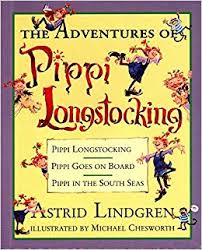Pippi and Sylvester
Listen to the Recess! Clip
| Author | John Cech (read by Fiona Barnes) |
| Air Date | 11/14/2001 |

Pippi and Sylvester Transcript
There aren’t two better writers to get carried away with during children’s book week than Astrid Lindgren and William Steig, who share the same birthday today. Ms. Lindgren, who’s a national hero in her native Sweden, is most famous for the Pippi Longstocking stories, that she first began telling aloud for her own nine-year-old daughter, Karin, in 1944. Karin, who was sick at the time, had demanded to hear about Pippi Longstocking — a name that the little girl, according to Lindgren, had made up on the spot. So her mother obliged and created a cycle of stories of a super strong, fun-loving, iconoclastic nine-year-old, who lives alone with her monkey in a house called Villa Villekulla and who has one spectacular escapade after another. No one can defeat Pippi — not burglars or the circus strong man, Adolf, or adult authority figures — she can eat a whole birthday cake in one sitting or lift a cow with one hand. The Pippi books haven’t been out of print since they first appeared in 1945, and now there’s a nice big collection of all three of the Pippi novels to carry your dreaming nine-year-old to the South Seas of the imagination.
William Steig is one of this country s most sophisticated writers and illustrators of picture books. His are subtle, acerbic fables about principled and clever mice dentists, like Dr. De Soto, who manages to outfox the fox with a bad bicuspid and an even worse attitude, and gritty children like Brave Irene, who makes a vital delivery in the middle of a blizzard to rescue her mothers dressmaking business. But Steig is perhaps best known for his stories about magical transformations — like Solomon the rabbit who becomes a rusty nail, and Sylvester, the donkey, who finds a magic pebble that can make any wish come true. And then there’s Shrek, the ogriest ogre of all.